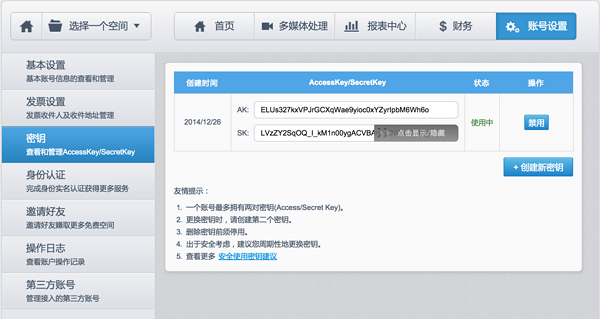
七牛云存储的 Python 语言版本 SDK(本文以下称 Python-SDK)是对七牛云存储API协议的一层封装,以提供一套对于 Python 开发者而言简单易用的开发工具。Python 开发者在对接 Python-SDK 时无需理解七牛云存储 API 协议的细节,原则上也不需要对 HTTP 协议和原理做非常深入的了解,但如果拥有基础的 HTTP 知识,对于出错场景的处理可以更加高效。
最近刚搭了个markdown静态博客,想把图片放到云存储中。
经过调研觉得七牛可以满足我个人的需求,就选它了。
要引用图片就要先将图片上传到云上。
虽然七牛网站后台可以上传文件,但每次上传都需要先登录,然后选择图片,设置连接地址,才能上传。
这个过程有些繁琐,所以我便想用七牛云提供的SDK写个一同步工具,方便增量同步文件。
有了这个想法,就马上行动。花了大概一个上午的时间,总算把这个工具给写出来,并放到GitOSC和github上。
#!/usr/bin/env python
#-*- coding:utf-8 -*-
#
# AUTHOR = "heqingpan"
# AUTHOR_EMAIL = "heqingpan@126.com"
# URL = "http://git.oschina.net/hqp/qiniu_sync"
import qiniu
from qiniu import Auth
from qiniu import BucketManager
import os
import re
access_key = ''
secret_key = ''
bucket_name = ''
bucket_domain = ''
q = Auth(access_key, secret_key)
bucket = BucketManager(q)
basedir=os.path.realpath(os.path.dirname(__file__))
filename=__file__
ignore_paths=[filename,"{0}c".format(filename)]
ignore_names=[".DS_Store",".git",".gitignore"]
charset="utf8"
diff_time=2*60
def list_all(bucket_name, bucket=None, prefix="", limit=100):
rlist=[]
if bucket is None:
bucket = BucketManager(q)
marker = None
eof = False
while eof is False:
ret, eof, info = bucket.list(bucket_name, prefix=prefix, marker=marker, limit=limit)
marker = ret.get('marker', None)
for item in ret['items']:
rlist.append(item["key"])
if eof is not True:
# 错误处理
#print "error"
pass
return rlist
def get_files(basedir="",fix="",rlist=None,ignore_paths=[],ignore_names=[]):
if rlist is None:
rlist=[]
for subfile in os.listdir(basedir):
temp_path=os.path.join(basedir,subfile)
tp=os.path.join(fix,subfile)
if tp in ignore_names:
continue
if tp in ignore_paths:
continue
if os.path.isfile(temp_path):
rlist.append(tp)
elif os.path.isdir(temp_path):
get_files(temp_path,tp,rlist,ignore_paths,ignore_names)
return rlist
def get_valid_key_files(subdir=""):
basedir=subdir or basedir
files = get_files(basedir=basedir,ignore_paths=ignore_paths,ignore_names=ignore_names)
return map(lambda f:(f.replace("\\","/"),f),files)
def sync():
qn_keys=list_all(bucket_name,bucket)
qn_set=set(qn_keys)
l_key_files=get_valid_key_files(basedir)
k2f={}
update_keys=[]
u_count=500
u_index=0
for k,f in l_key_files:
k2f[k]=f
str_k=k
if isinstance(k,str):
k=k.decode(charset)
if k in qn_set:
update_keys.append(str_k)
u_index+=1
if u_index > u_count:
u_index-=u_count
update_file(k2f,update_keys)
update_keys=[]
else:
# upload
upload_file(k,os.path.join(basedir,f))
if update_keys:
update_file(k2f,update_keys)
print "sync end"
def update_file(k2f,ulist):
ops=qiniu.build_batch_stat(bucket_name,ulist)
rets,infos = bucket.batch(ops)
for i in xrange(len(ulist)):
k=ulist[i]
f=k2f.get(k)
ret=rets[i]["data"]
size=ret.get("fsize",None)
put_time = int(ret.get("putTime")/10000000)
local_size=os.path.getsize(f)
local_time=int(os.path.getatime(f))
if local_size==size:
continue
if put_time >= local_time - diff_time:
# is new
continue
# update
upload_file(k,os.path.join(basedir,f))
def upload_file(key,localfile):
print "upload_file:"
print key
token = q.upload_token(bucket_name, key)
mime_type = get_mime_type(localfile)
params = {'x:a': 'a'}
progress_handler = lambda progress, total: progress
ret, info = qiniu.put_file(token, key, localfile, params, mime_type, progress_handler=progress_handler)
def get_mime_type(path):
mime_type = "text/plain"
return mime_type
def main():
sync()
if __name__=="__main__":
main()这个同步脚本支持批量比较文件,差异增量更新、批量更新。
使用方式
安装七牛Python SDK
pip install qiniu
填写脚本文件(qiniusync.py)的配置信息
access_key = '' secret_key = '' bucket_name = ''
注册后可以拿到对应的信息
将脚本文件(qiniusync.py)拷贝到待同步根目录
运行脚本
python qiniusync.py
后记
写完提交之后才发现,七牛已经提供相应的工具,我这个算是重复造轮子吧。
既然已经写,就发出来,当做熟悉一下七牛的SDK也不错,说不定以后还能用的上。
七牛云存储Python SDK使用教程
本教程旨在介绍如何使用七牛的Python SDK来快速地进行文件上传,下载,处理,管理等工作。
安装
首先,要使用Python的SDK必须要先安装。七牛的Python SDK是开源的,托管在Github上面,项目地址为 https://github.com/qiniu/python-sdk 。
安装的方式可以如项目的说明上所说,用 pip install qiniu 。当然也可以直接 clone 一份源代码下来直接使用。我一般喜欢直接 clone 源代码,这样的话,如果要对SDK做一些改动也是十分容易的。
最新版本的Python SDK需要依赖 requests 库,所以要提前安装好。安装方式当然也可以用 pip install requests 。
开发环境
Python的开发环境有很多种选择,如果喜欢文本的方式,比如vim,emacs,sublime text等都是很好的选择,如果你喜欢IDE,那么最流行的莫过于 PyCharm 了。 PyCharm 的最新版本到 这里下载。
Access Key和Secret Key
我们知道七牛云存储的权限校验机制基于一对密钥,分别称为 Access Key 和 Secret Key 。其中 Access Key 是公钥, Secret Key 是私钥。这一对密钥可以从七牛的后台获取。

小试牛刀
好了,做了上面的这些准备工作,我们就去上传一个简单的文件,练练手。
python #coding=utf-8 __author__ = 'jemy' '''
本例演示了一个简单的文件上传。
这个例子里面,sdk根据文件的大小选择是Form方式上传还是分片上传。
'''
import qiniu
accessKey = "<Your Access Key>"
secretKey = "<Your Secret Key>"
#解析结果
def parseRet(retData, respInfo):
if retData != None:
print("Upload file success!")
print("Hash: " + retData["hash"])
print("Key: " + retData["key"])
#检查扩展参数
for k, v in retData.items():
if k[:2] == "x:":
print(k + ":" + v)
#检查其他参数
for k, v in retData.items():
if k[:2] == "x:" or k == "hash" or k == "key":
continue
else:
print(k + ":" + str(v))
else:
print("Upload file failed!")
print("Error: " + respInfo.text_body)
#无key上传,http请求中不指定key参数
def upload_without_key(bucket, filePath):
#生成上传凭证
auth = qiniu.Auth(accessKey, secretKey)
upToken = auth.upload_token(bucket, key=None)
#上传文件
retData, respInfo = qiniu.put_file(upToken, None, filePath)
#解析结果
parseRet(retData, respInfo)
def main():
bucket = "if-pbl"
filePath = "/Users/jemy/Documents/jemy.png"
upload_without_key(bucket, filePath)
if __name__ == "__main__":
main()运行结果为:
Upload file success!
Hash: Fp0XR6tM4yZmeiKXw7eZzmeyYsq8
Key: Fp0XR6tM4yZmeiKXw7eZzmeyYsq8
从上面我们可以看到,使用七牛的Python SDK上传文件的最基本的步骤是:
1.生成上传凭证
2.上传文件
3.解析回复结果
小结
综上所述,其实使用七牛的SDK来上传文件还是很简单的,接下来的教程,我们将在这个例子的基础上逐步了解更多关于文件上传的知识。
 Comment résoudre l'erreur inconnue 11
Comment résoudre l'erreur inconnue 11
 A quoi sert la gestion du stockage ?
A quoi sert la gestion du stockage ?
 fonction système()
fonction système()
 Comment résoudre l'erreur d'analyse syntaxique
Comment résoudre l'erreur d'analyse syntaxique
 Quelles sont les techniques de test courantes ?
Quelles sont les techniques de test courantes ?
 Méthode de mise en œuvre de la fonction de lecture vocale Android
Méthode de mise en œuvre de la fonction de lecture vocale Android
 Tutoriel de création de site Web simple PHP
Tutoriel de création de site Web simple PHP
 Comment configurer le routeur
Comment configurer le routeur